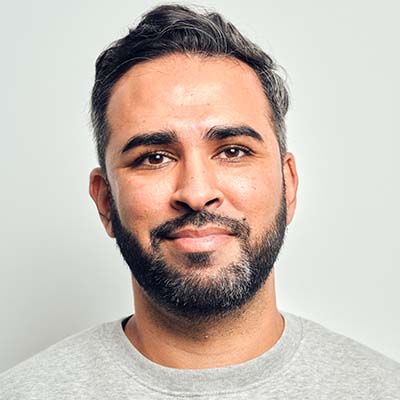

- Gurjit Pannu
- Co-Founder, Co-CEO, Palm

- Tom Alford
- Deputy Editor, Treasury Management International
My Life in Treasury: Gurjit Pannu, Co-Founder, Co-CEO, Palm
Gurjit Pannu, Co-Founder, Co-CEO, Palm, talks frankly to TMI about what inspired his move from corporate treasury into the fintech space and why he feels treasury now has a perfect opportunity to rise to prominence.
Sweden/Netherlands-based Palm was created in January 2023 as a real-time automated treasury software solution. Built from the ground up, the API-connected platform uses AI to enhance cash forecasting and investment decisions.
As the conduit between Palm’s product development team and its corporate treasury customers, Gurjit’s role is often focused on finding new pathways. But in translating the often critical needs of the treasury community into a functioning technical solution, he is able to draw upon many years’ experience at the sharp end of corporate finance, both in treasury and banking.
Gurjit first “landed in treasury” when joining State Street in 2007. He moved between its global trade operations, futures trade, and collateral management desks. “Banking treasuries are quite different from corporate treasuries, so early on for me what was really exciting, being fresh out of college, was seeing billions of dollars being moved around, and being a part of that.”
Coming from a small farming town in California, Gurjit admits he’d never imagined that one day he would be making multi-billion-dollar transactions. Of course, he’d never imagined what global event was just around the corner either. As the 2008 global financial crisis tightened its grip on the world, he admits “things got a little bit choppy at the bank”.
Moving between different departments, he was tasked with supporting the operational side. With a ready appreciation for money movement but also for talking to different stakeholders, he made the decision “to apply for and jump to the corporate treasury side”, becoming Senior Treasury Analyst, Levi Strauss & Co.
Levi’s was followed by six years at Uber, rising from Senior Treasury Analyst, via Treasury Manager, EMEA, to Senior Treasury Manager, EMEA APAC. More latterly Gurjit held the position as Director, Global Head of Treasury, Remote (a global HR platform provider). “The way my career has progressed has always felt like it was getting closer to treasury from day zero, but in the reverse chronological order!”
He explains: “Starting at Levi’s, I experienced a traditional, fully mature, treasury – from front to middle to back office – taking on cash management, FX, hedging, risk management and investments, which was really cool. When I joined Uber, I was also able to experience the stage before that, scaling up a treasury team and function from about 10 countries to the ambitious goal of being in every country in the world. I also witnessed this hyper-growth phase, from foundational treasury to thinking about the strategic aspect, winding up businesses, winding down businesses, mergers and acquisitions, all the way to the IPO. That was really exciting.”
With his first exposure to treasury, Gurjit saw the finished article. He was then taken back to basics to witness how that structure was built and developed. “And then when I left Uber and joined Remote, I was faced with a blank sheet of paper and the prospect of building a treasury from scratch.”
It’s this reverse-engineering approach – taking a step back each time, learning, and then building forward – that has sustained Gurjit’s interest in treasury over the years. With the creation of Palm, he is continuing his journey. By launching a fintech aimed at helping established treasuries to progress, not only is he setting out from a point that is one step back from his previous role, but he also knows he will not have a formal treasury in the business until it has grown in stature.
This may not take too long, with Gurjit well placed to offer third-party treasury solutions. Across a 10-year period in the treasury space he has implemented three separate TMSs: at Levi’s, Uber and Remote. From first to last, he noted that certain tools had barely changed in all that time.
“They could be really frustrating to use, often took a long time to implement, and had a steep learning curve that became even more challenging when we were operating in a remote environment,” he explains. But working at tech-first firms Uber and Remote exposed him to many fintech innovations and the kind of thinking that enabled him to see “a clear opportunity to build something new for treasurers”.
Adapting ‘on the fly’
A meeting with future Palm Co-Founder Christian Sobkowski, a product developer with experience at PayPal and iZettle, revealed a shared perception that treasurers were not getting the technology they needed. “We said, ‘Let’s talk to treasurers.’ We wanted to know for sure whether what we were thinking and feeling was just us, or if this was a common occurrence.”
Around six months and 75 or so conversations later, it became clear that treasurers representing all types and sizes of business in Europe, the US and Asia were indeed “looking for different solutions”. The Palm challenge was on.
While it was clear that most treasuries have technology issues they’d like to address, in seeking out the most common needs, the complexity of established enterprise-level treasury became the natural starting point for Palm. It was reasoned that smaller or newer operations did not necessarily face the same level of need as their larger counterparts and that there would be a bigger market for the larger players.
Identifying common issues for treasurers, and building a product to meet those needs, incorporates the experiences of many other treasurers, not least those of Gurjit himself. While relevant technical knowledge is essential, he believes it is the skills that are applicable to many other fields, not just treasury, that make the difference in this profession. “We need to be good communicators, have a genuine curiosity about life, and be able to prioritise. It’s these soft skills that have really helped throughout my career.”
Adaptability is also crucial, he continues. This is especially true when working in businesses that are in growth mode. “It can be difficult to know what the most appropriate approach to treasury is sometimes, because what works today may not do so tomorrow. It’s why I believe being able to adapt ‘on the fly’ has been really key for me.”
Of course, success is not just about the individual, and for Gurjit, “no matter how insurmountable you feel a challenge is, if you surround yourself with sharp, ambitious, diverse people, it can usually be overcome”.
The strong team element is something that Gurjit naturally insists on bringing to Palm. He has hired a small but truly global group (its members representing five continents), that personifies all the attributes he values. The level of experience Palm has attracted is also significant, with people from the technical sides of organisations such as Stripe, PayPal, Booking.com, and Google bringing “energy and hunger for a challenge”.
Invested in the idea that ‘no one is the finished product’, Gurjit is motivated to keep advancing, from both a personal and a business viewpoint. “The shift from the specialised niche that is treasury, to building a business from the ground up, means there is quite a bit to learn.”
One area of personal development for him has been to build upon his understanding of the technology that underpins the Palm platform. “What’s been a huge wake-up call for me is the level of complexity at the back end of the software that we use,” he admits. “I’ve certainly begun to understand and appreciate how the intricacies of even the simplest consumer tools enable them to feel simple. A great UX is no accident. I’ve learnt a huge amount about product development and all the work that goes on in the background to make that happen.”
And while Gurjit has many years of treasury practice under his belt, his technical understanding, and inevitable use of jargon, has had to be brought back down to earth to ensure his IT colleagues fully grasp that side of the process.
“I’ve adopted the ‘explain it like I’m five’ strategy because it forces me to remove the technical terms and get to the heart of what’s important.” The same strategy is used to good effect by Palm’s IT team to explain its processes, ensuring everyone understands what’s needed. It is, he says, “like learning to communicate with a different language”.
‘It’s a mistake to think treasury isn’t exciting’
Having identified a set of specific technology needs within the targeted section of the treasury community, Palm is focusing on cash forecasting. “It’s the number one or two priority for many treasurers, especially those at enterprise level,” notes Gurjit. “The onus has always been on treasury to speak to different teams across the organisation, understand the business patterns and their impacts, and identify the correct sources of data. Having done it myself a few times, I know that building your first forecast can be intimidating. It’s difficult to know even where to start… and then you discover that it’s an ever-evolving process.”
If accurate forecasting requires time and knowledge and experience of the business to maintain it, it’s a clear and present risk that this information could be lost as people come and go, he warns. “And then the knowledge of how your business works is not fully ingrained into your forecasts.”
But, Gurjit adds, while newcomers to treasury often exert a positive influence on the department, it’s often the case, as demonstrated in many TMI My Life in Treasury articles, that those new to treasury arrive without prior experience or knowledge of the function’s finer points. As he comments: “We don’t go to ‘treasury university’; we typically just fall into the role”.
It is therefore surely incumbent upon treasury leaders to nurture and develop newcomers, suggests Gurjit. “We have to help them become future treasury leaders, to excite them about the impact of treasury, and to reveal to them the full impact they can have across the business. It’s a waste to lose them to mundane manual tasks, frustrating legacy tools, and a mistaken perception that treasury is not really that exciting.”
This view informs Palm’s focus on designing and building technology that is intuitive for all. “We want it to feel more like a consumer experience than a large enterprise system.” From an operational perspective, with the current iteration’s spotlight on enhancing forecasting, the goal is to enable teams to automate the process and retain the knowledge within the system.
“Think of it as your in-house analyst; it’s a part of your team that’s always going to be a part of your team,” explains Gurjit. “It will have the essential knowledge, context, and history that enables a group to constantly improve its forecasting. Treasury can take that information and insight to the business, highlighting its role as a strategic partner, rather than being one that collects reports from different sources, punches in numbers, and publishes reports.”
Opinion matters
With a purposefully diverse and small number of beta customers already using the platform, and each offering valuable feedback, the Palm offering is close to production, reveals Gurjit. He believes that this beta group will play an important part in Palm’s development roadmap, taking it beyond cash forecasting and liquidity management, and into other core treasury areas such as FX, investments, and payments.
The research and client engagement work seems to be paying off. Allowing Palm a “pat on the back, a little bit”, Gurjit says the cash forecasting models “have been able to provide more accurate forecasts in three out of four accounts when compared with the experienced personnel that are doing these today”.
Of course, Gurjit has his own raft of direct experiences at the sharp end of these issues. He is nonetheless encouraged by the receptiveness of other treasurers to talking about their own involvement and frustrations, and making the time to provide much-needed feedback to Palm’s development team.
The treasury professionals seeking involvement are a “diverse crowd”, and they have a range of reasons for getting on board, says Gurjit. Some are experiencing challenges now, often at the hands of a business transformation. “The most common one we’ve seen is where a group has been bought out by an investment firm, such as a private equity fund, and the new owners want more visibility on group cash,” he notes.
Elsewhere, some have been mandated to improve their cash efficiencies, and have budget to procure a suitable tool. Others are committed early adopters, with years of experience implementing systems, but now seeking a fintech partner open to co-development.
“We deliberately wanted a diverse group of beta customers,” states Gurjit. “We knew that it would not only give us the best chance of achieving a holistic view of recurring treasury challenges but also that these treasurers would be more willing to share what their ideal solution for common and persistent issues should look like.”
Of course, having an ‘ideal solution’ in mind is not the same as having an actual solution deployed. But one of the most persistent points of resistance to new treasury technology adoption is budget. How does this impact the progress of Palm?
“Whether it’s budget for technology or for personnel, it’s always been a constraint for treasuries,” comments Gurjit. Having worked in some high-tech businesses, where the best engineers were on tap, he recalls that “as a treasury team, we didn’t have access to those resources”. Given the value of treasury to the business, it sounds self-defeating. But he explains that these experts were focused wholly on the core product. “We had to figure out how to obtain the budget for the tools that we needed. Building a strong business case was absolutely key there.”
To achieve this, Gurjit might aim to help other teams in the business understand the value of a new system to the group. Here, he focuses on how technology can enable treasury to perform far more than just operational tasks, stepping up to provide other functions with more timely and strategic information to enhance the value of their own profit-centre activities.
Seeing through the GenAl buzz
As with many of today’s fintechs, Palm uses a mix of open source and proprietary AI algorithms to help formulate its output. The use of AI has been “quite a learning journey for me” admits Gurjit. To get up to speed, he worked with a number of expert practitioners, helping him to understand the nuances of AI’s two main forms, predictive AI and Generative AI (GenAI).
Predictive AI has been used for decades, its algorithms already employed in many commercial settings such as marketing, manufacturing, and risk management. Its execution is improving rapidly, comments Gurjit. “However, what’s really ‘buzzy’ now is GenAI.”
This is more about new content creation, whether it’s text, art, music, video, or even code. “But there is a risk of getting lost in that ‘buzziness’ and trying to apply it everywhere,” he warns. Citing the increasing adoption of copilots and chatbots, for example, he accepts that while these can be helpful, he questions whether such tools are the “big innovative shift” that’s going to change the treasury world. “I think for now, maybe not.”
Nonetheless, Gurjit agrees that GenAI, and especially large learning models, could have a positive impact on treasury document management. “In a process such as the application of policy, it could be advantageous to upload a PDF of treasury policy into a system that can automatically read and then apply it across all bank accounts, hedging or investments, for example, and then confirm compliance or warn when you are outside policy.”
Throwing off mundanity, replacing with positive purpose
The existential threat of AI to some professional activities is real. While the idea that treasury could be an AI-based app consuming data and orchestrating all movements, deals, and risk mitigation, might be compelling for some CFOs, Gurjit is adamant that technology is not about to replace any treasurer.
“There’s more to it than just moving money into the right place at the right time,” he states. “That’s why we’re increasingly seeing treasurers offered a seat at the table. Technology enables processes, but it’s more accurate to say it enables people. So it will not replace treasury teams, rather, it will replace some aspects of what they do.”
A perhaps contrary notion (for a CFO who wants a robot treasury) mooted by Gurjit is that of nurturing more people to build their careers within treasury. “We need to enable human treasurers to throw off all their mundane operational activities, and provide them with all the information they need to make decisions that have a positive impact on the business; technology should be used to repurpose not replace people.”
Given the technology that is now available to treasury, would Gurjit be more excited about the profession now than he was when he first started? He admits that during his first foray as a treasury analyst he wasn’t sure of his real purpose. “I was told that these numbers come in, you make sure they make sense, and then you execute this wire transfer. It took time for me to understand the true impact treasury has on the business. Today, technology shortens the learning curve, opening up the opportunity for a greater understanding of the impact you’re having on the business. And that is far more exciting.”
Having served his treasury apprenticeship through traditional means, Gurjit has nevertheless found it to be an extremely satisfying profession. But he now hopes that the launch of Palm – as a solution aimed at giving treasurers a greater understanding of their core processes – both advances the case for continued treasury expertise, and helps individuals move closer to where they want to be, making a conspicuous and positive impact on the wider business.



